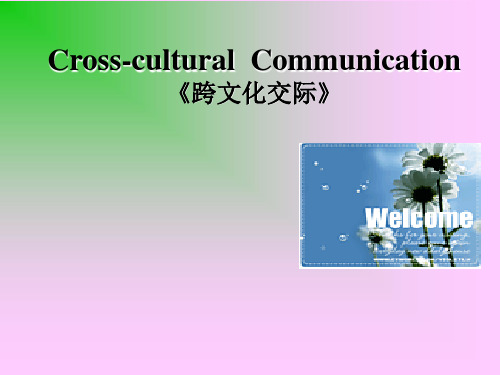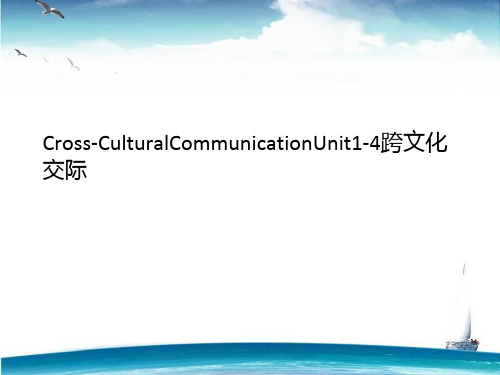跨文化交际(英文PPT)
合集下载
跨文化交际 英文PPT课件

▪ 与陌生人交际——跨文化交流方法(第四 版)William B.Gudykunst & Young
▪ Yun Kim著,Steve Kulich 等导读
▪ 跨文化交际学基础,GuoMing Chen & William J.Starosta 著,林大 津、尤泽顺导读
▪ 跨文化能力:文化间人际沟通导论(第五 版)Myron W.Lustig & Jolene Koester 编 著,庄恩平导读
2. Do you sometimes find it hard to make yourself
properly understood by others? If you do, whard? .
4
Warm Up
▪ It is very difficult for people to understand one another
which people respond, the automatic reactions they
have to whatever they see and hear. These often differ,
and the differences may introduce misunderstandings
if they do not share the same experiences. Of course, we
all share the experience of being human, but there are
many experiences which we do not share and which are
everywhere”?
5. What are the major elements that directly influence our
Cross-cultural Communication 跨文化交际 PPT课件 (2)

5.Case studies
Mutual Monitoring Process
Xiu went to a BC buffet reception in the BC headquarters in Beijing. It just so happened that Xiu arrived a little too early. The waiting lounge was almost empty except a charming lady sitting at a corner seat. After a long interval of unbearable silence Xiu decided to break the silence by approaching the lady.
Yes, but not good
1.An orator delivers a speech to a large gathering. 3. You send an e-mail message to an American friend. 4.Jane lies in bed reading a novel.
Model Two: unilateral-cultural model
(one knows another’s language and cultural environment but the other one doesn’t)
Lu Bing ,a Chinese tour guide is talking in English with George Luke, a British tourist who does not know Chinese at all.
Activity 3: Meanings in communication
跨文化交际(英文PPT)

the issues concerning intercultural communication .
III. Plan.
1.Required Textbook :Communication Between Cultures (Third Edition)By Larry A. Samovar Richard E. Porter Lisa A. Stefani 2000 2. Time schedule: 36 periods in one term. 1).Introduction to Intercultural Communication ;4periods 2).Part I Communication and Culture; 8 periods 3).Part II The Influence of Culture ; 8 periods 4).Part III From Theory of Practice; 8 periods 5).Part IV Knowledge into Action; 8 periods 3. Evaluation will be based on: 1)Attendance and participation. 2)Project presentation and handout (the required essay ). 3)Final examination.
The book is divided into four interrelated parts, including 10 chapters: (Look at P.F28)
Part I introduces the study of communication and culture(Chapter1-2);
III. Plan.
1.Required Textbook :Communication Between Cultures (Third Edition)By Larry A. Samovar Richard E. Porter Lisa A. Stefani 2000 2. Time schedule: 36 periods in one term. 1).Introduction to Intercultural Communication ;4periods 2).Part I Communication and Culture; 8 periods 3).Part II The Influence of Culture ; 8 periods 4).Part III From Theory of Practice; 8 periods 5).Part IV Knowledge into Action; 8 periods 3. Evaluation will be based on: 1)Attendance and participation. 2)Project presentation and handout (the required essay ). 3)Final examination.
The book is divided into four interrelated parts, including 10 chapters: (Look at P.F28)
Part I introduces the study of communication and culture(Chapter1-2);
跨文化交际英文英语ppt

• In life some minor a neglected social practice can also be seen as the differences in Western culture. For example, Westerners think the sound while eating is not appropriate. But eat in Asian the sound is considered to the cook, appreciation and satisfaction.
prayer.
• 还有不同文化中不同的祷告仪式。 • There are different culture in different prayer.
Different culture in different prayer.
东西方文化中不同的葬礼仪式 Different in the form of a funeral. Chinese usually took the form of weeping mourners. Americans are in a manner of silence to honor.
就这些了 That's all~~谢谢观赏Th源自nk you to watch!!
泮蕾蕾Leilei.pan 张艳霞Yanxia.zhang 白彬Bin.bai
辛国鑫Guoxin.xin 毕建平Jianping.B
感谢您的阅读! 为 了 便于学习和使用, 本文档下载后内容可 随意修改调整及打印。
wedding ceremony
• 东西方文化中不同的婚礼以仪式。西方文化中婚礼要在教堂中许下誓 言。在中国要进行夫妻交拜。
• Eastern and Western cultures, different wedding ceremony.Western culture in the wedding vows in the pay worship to be in China.
prayer.
• 还有不同文化中不同的祷告仪式。 • There are different culture in different prayer.
Different culture in different prayer.
东西方文化中不同的葬礼仪式 Different in the form of a funeral. Chinese usually took the form of weeping mourners. Americans are in a manner of silence to honor.
就这些了 That's all~~谢谢观赏Th源自nk you to watch!!
泮蕾蕾Leilei.pan 张艳霞Yanxia.zhang 白彬Bin.bai
辛国鑫Guoxin.xin 毕建平Jianping.B
感谢您的阅读! 为 了 便于学习和使用, 本文档下载后内容可 随意修改调整及打印。
wedding ceremony
• 东西方文化中不同的婚礼以仪式。西方文化中婚礼要在教堂中许下誓 言。在中国要进行夫妻交拜。
• Eastern and Western cultures, different wedding ceremony.Western culture in the wedding vows in the pay worship to be in China.
Cross-CulturalCommunicationUnit1-4跨文化交际.ppt

• In order to study cross-cultural communication, we must pay attention to the following:
a) Each individual are unique. b) Stereotyping. c) Objectivity. d) Communication is not a Cure-all.
CHAPTER 1 - Communication and Culture: The Challenge of The Future
• Culture is – Transmitted from generation to generation – Learned – Shared – Based on symbols – Dynamic – An intergrated system
Cross-CulturalCommunicationUnit1-4跨文化 交际
CHAPTER 1
Communication and Culture: The Challenge of The Future
CHAPTER 1 - Communication and Culture: The Challenge of The Future
– increased the probability of survival
– satisfaction for the participants in an ecological niche
– share with those who could communicate with each other and lived in the same tCommunication:
a) Each individual are unique. b) Stereotyping. c) Objectivity. d) Communication is not a Cure-all.
CHAPTER 1 - Communication and Culture: The Challenge of The Future
• Culture is – Transmitted from generation to generation – Learned – Shared – Based on symbols – Dynamic – An intergrated system
Cross-CulturalCommunicationUnit1-4跨文化 交际
CHAPTER 1
Communication and Culture: The Challenge of The Future
CHAPTER 1 - Communication and Culture: The Challenge of The Future
– increased the probability of survival
– satisfaction for the participants in an ecological niche
– share with those who could communicate with each other and lived in the same tCommunication:
跨文化交际 英文ppt

e is collectivism(集体 主义) culture, and it is the great power distance culture."
•
American culture is individualistic (个人主义)culture, and it is the culture of "small power distance".
Thank you!
——张和玉
Question • 1.Why does Li Ming stand up suddenly? • 2.Why his boss will misunderstand his behavior?
This is mainly because of the power distance(权力距离). Most individualistic(个人主义) culture is also a “small power distance” culture. People with such cultural backgrounds(背景) tend to think that all men are created equal(人人平等) In such a culture, often not because of age, seniority(辈分), on the lower level of the difference between the both sides of communication differential(区别) treatment(对待) of each other.
No Stand-up When Your Leader Comes In
•
I’m Li Ming. I worked in an American company. When my boss came into my office for the first time, I stood up immediately(立即) to show my respect. The boss misunderstood my behavior, thought I was going out, and said he would tail with me in a while. I was accustomed (习惯) to respecting all those in authority.
•
American culture is individualistic (个人主义)culture, and it is the culture of "small power distance".
Thank you!
——张和玉
Question • 1.Why does Li Ming stand up suddenly? • 2.Why his boss will misunderstand his behavior?
This is mainly because of the power distance(权力距离). Most individualistic(个人主义) culture is also a “small power distance” culture. People with such cultural backgrounds(背景) tend to think that all men are created equal(人人平等) In such a culture, often not because of age, seniority(辈分), on the lower level of the difference between the both sides of communication differential(区别) treatment(对待) of each other.
No Stand-up When Your Leader Comes In
•
I’m Li Ming. I worked in an American company. When my boss came into my office for the first time, I stood up immediately(立即) to show my respect. The boss misunderstood my behavior, thought I was going out, and said he would tail with me in a while. I was accustomed (习惯) to respecting all those in authority.
英文版跨文化交际PPT课件

east&west
12/14/2019
1
1.gift
This is the American way to open gifts, they usually opened directly after dinner received a gift. Directly express their own joy.
wedding vows in the
church.Couples pay worship to be
2019/12/14
10
WOW!!。。。。。
2019/12/14
11
额。。。。。。。
2019/12/14
12
虽然每一种文化都有自己的社会做法。但是每一个 人都是独特的不同的,每个人都可以选择自己喜欢 的做法。
2019/12/14
9
wedding ceremony
• 东西方文化中不同的婚礼以仪式。西方文化中婚礼要在教堂中许下誓 言。在中国要进行夫妻交拜。
• Eastern and Western cultures,
different wedding
ceremony.Western culture in the
But, in China, gifts are never opened in front of giver, and doing so is considered
bad manners. So people had to hide his feelings .
这是社会做法的外在表现的一方面。 This is the the outward manifestations aspect of social practices
12/14/2019
1
1.gift
This is the American way to open gifts, they usually opened directly after dinner received a gift. Directly express their own joy.
wedding vows in the
church.Couples pay worship to be
2019/12/14
10
WOW!!。。。。。
2019/12/14
11
额。。。。。。。
2019/12/14
12
虽然每一种文化都有自己的社会做法。但是每一个 人都是独特的不同的,每个人都可以选择自己喜欢 的做法。
2019/12/14
9
wedding ceremony
• 东西方文化中不同的婚礼以仪式。西方文化中婚礼要在教堂中许下誓 言。在中国要进行夫妻交拜。
• Eastern and Western cultures,
different wedding
ceremony.Western culture in the
But, in China, gifts are never opened in front of giver, and doing so is considered
bad manners. So people had to hide his feelings .
这是社会做法的外在表现的一方面。 This is the the outward manifestations aspect of social practices
Cross-CulturalCommunicationUnit1-4跨文化交际.ppt

CHAPTER 1 - Communication and Culture: The Challenge of The Future
Dominant Culture
Co-Cultures
• It's the one in power -
• They are numerous.
control.
• Distinct and unique
• We learned our culture through mass media
• Culture is transmitted from generation to generation
• Culture is based on symbols
• Culture is subjected to change
• Subjective elements include: values, beliefs, attitudes, orientations, and underlying assumptions prevalent among people in the society.
• Basic functions of Culture: adapt to a particular ecology, and includes the knowledge that people need to have in order to function in their own social environment.
• Culture is integrated
• Culture is adaptive
CHAPTER 1 - Communication and Culture: The Challenge of The Future
- 1、下载文档前请自行甄别文档内容的完整性,平台不提供额外的编辑、内容补充、找答案等附加服务。
- 2、"仅部分预览"的文档,不可在线预览部分如存在完整性等问题,可反馈申请退款(可完整预览的文档不适用该条件!)。
- 3、如文档侵犯您的权益,请联系客服反馈,我们会尽快为您处理(人工客服工作时间:9:00-18:30)。
VIII. Approaches
to the study of ICC
Three Approaches: 1.the social science approach (sometimes called alist approach) 2. the interpretive approach 3. the critical approach
Communication Theories.
7. In the 1990s Theory construction and testing continues.
VII. The nature of the study of ICC:
Interdisciplinary:
1. Linguists : Edward Sapir and Benjamin Whorf and their hypothesis :the Edward Sapir-Whorf hypothesis(萨丕 Sapirhypothesis(萨丕 尔 沃尔夫假设 ) 2. Anthropologists Edward Hall and his works: The Silent Language 3. Psychologists : Gordon Allport and his classic study, The Nature of prejudice
INTERCULTURAL COMMUNICATION
"People fail to get along because they fear each other; They fear each other because they don't know each other; They don't know each other because they have not communicated with each other." Dr. Martin Luther King, Jr.
IV. Course expectations/tasks
1.Preview the text :Looking up the new words and expressions before class; Prepare what the teacher has asked you to do. 2.Take an active part in class discussions and performances. 3. Choose and read two recommended textbooks on intercultural communication - one in Chinese and one in English. Books Recommended: [1] Ron Scollon Suzanne Wong Scollon :Intercultural Communication: A Discourse Approach , 外语教学与研究出版社,2000* 外语教学与研究出版社,2000* [2] 贾玉新:《跨文化交际学》,上海外语教育出版社,1997 贾玉新:《跨文化交际学》,上海外语教育出版社,1997 [3] 林大津:《跨文化交际研究》,福建人民出版社, 1996 林大津:《跨文化交际研究》 [4] 胡文仲:《文化与交际》,外语教学与研究出版社,1997 胡文仲:《文化与交际》,外语教学与研究出版社,1997
III. Plan.
1.Required Textbook :Communication Between Cultures (Third Edition)By Larry A. Samovar Richard E. Porter Lisa A. Stefani 2000 2. Time schedule: 36 periods in one term. 1).Introduction to Intercultural Communication ;4periods 2).Part I Communication and Culture; 8 periods 3).Part II The Influence of Culture ; 8 periods 4).Part III From Theory of Practice; 8 periods 5).Part IV Knowledge into Action; 8 periods 3. Evaluation will be based on: 1)Attendance and participation. 2)Project presentation and handout (the required essay ). (the 3)Final examination.
Welcome
Welcome to the class of intercultural communication course!! In this course, we are all learners and teachers. Your experiences and capacities are valuable resources for me. Respect for yourself and others is an essential ingredient in creating a positive learning environment. I look forward to working with you to create this kind of learning environment.
V. Introduction to the textbook
Synopsis This textbook gives you an understanding and appreciation of different cultures and provides you with the practical skills for improving your communication with people from other cultures. It provides excellent motivation for you through numerous compelling examples that force them to examine your own assumptions and cultural biases. Structure The book is divided into four interrelated parts, including 10 chapters: (Look at P.F28) Part I introduces the study of communication and culture(Chapter1-2);
I. Importance of studying ICC
To behave as “good citizens” in the global citizens” village it is important for us to cultivate sufficient intercultural awareness; to achieve communicative competence; to competence; study ICC.
II. Course Objectives/purposes
The specific course objectives are as follows: 1. To acquire knowledge related to ICC (terminologies and definitions) ; 2. To develop skills that will increase your intercultural communication competence; 3. To understand how communication processes differ among cultures; 4.To cultivate the ability to study and explore the issues concerning intercultural communication .
Structure
The book is divided into four interrelated parts, including 10 chapters: (Look at P.F28) Part I introduces the study of communication and culture(Chapter1-2); Part II examines cultural patterns of behavior and then looks at the deep structures as the basic roots of cultural behavior( Chapter3-4) Part III puts the theory of intercultural communication into practice;(Chapter5-9); Part IV is concerned with the improvement of intercultural communication skills(Chapter10).
2.In 2.In 1959 : The publication of the Silent Language by the American cultural anthropologist, Edward T.Hall marked the emergence of ICC. 3.In 1966: ICC was regarded as curriculum in the US. 4. In 1970: ICC was recognized as an independent area of study by the International Communication Association (国际传播学会) 国际传播学会) 5. In 1972: The first international conference on intercultural communication was held in Japan. 6. In 1983 : Gudykunst ,American well known scholar in ICC, edited the first text on intercultural communication theory, Intercultural
